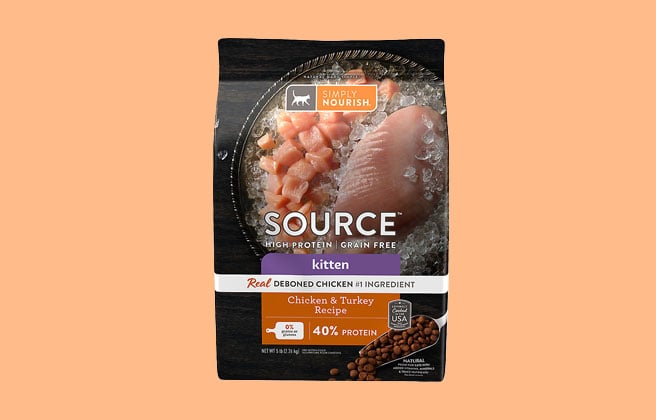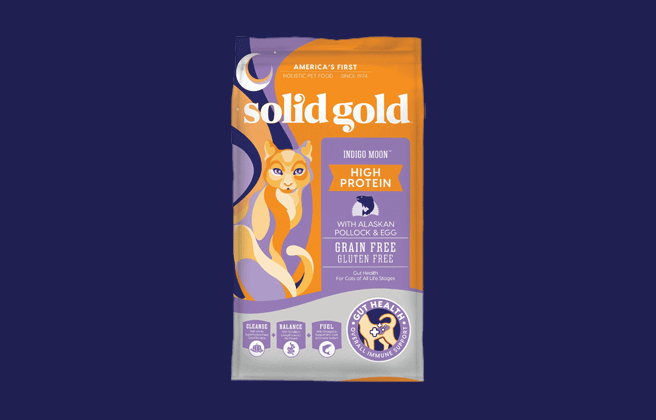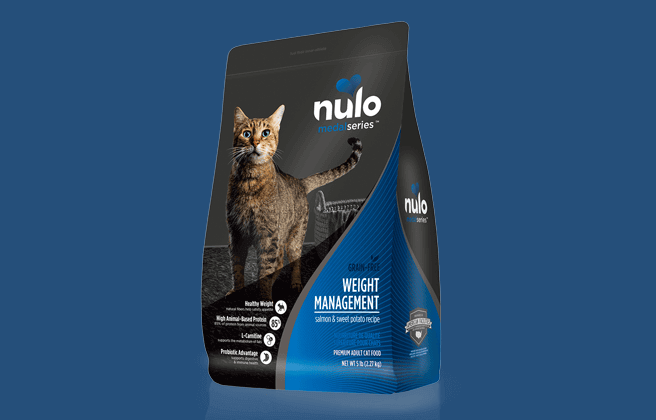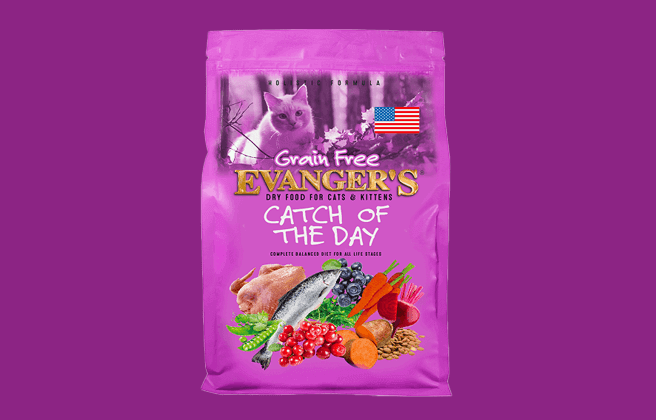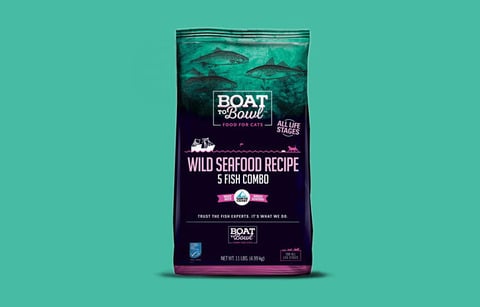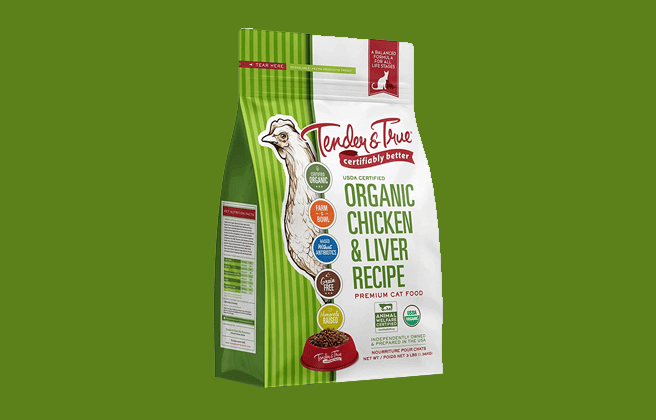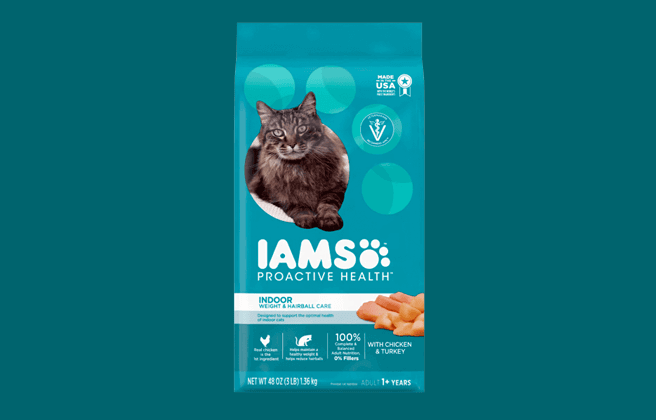
Our Verdict
The IAMS Proactive Health dry product range is made of 13 recipes which all receive 2.5 stars.
It is formulated to meet the nutritional levels established by the AAFCO cat food nutrient profiles for all adult and kitten maintenance.
Each recipe in the range is tailored to meet the nutritional needs of cats at different stages of life.
Pros
- Helps with easy weight control
- High in fiber to support digestive health
- Chicken is the number 1 ingredient
- Highly recommended by many veterinarians
Cons
- Contains more corn than expected
- Contains preservatives
- Caramel coloring
The table below shows each recipe in the range including our rating and the AAFCO nutrient profile: Growth (kitten), Maintenance (adult), All Life Stages, Supplemental or Unspecified.
| Product line | Rating | AAFCO |
|---|---|---|
| IAMS Indoor Weight & Hairball Care with Chicken & Turkey | 2.5 | M |
| IAMS Health & Enjoyment with Chicken & Beef | 2.5 | M |
| IAMS Health & Enjoyment with Chicken & Salmon | 2.5 | M |
| IAMS Long Hair Care with Chicken & Salmon | 2.5 | M |
| IAMS Indoor with Salmon | 2.5 | M |
| IAMS Sensitive Digestion & Skin with Turkey | 2.5 | M |
| IAMS Hairball Care with Chicken & Salmon | 2.5 | M |
| IAMS Healthy Adult with Chicken | 2.5 | M |
| IAMS Healthy Adult with Salmon | 2.5 | M |
| IAMS Healthy Kitten with Chicken | 2.5 | G |
| IAMS High Protein with Chicken & Salmon | 2.5 | M |
| IAMS Urinary Tract Health with Chicken | 2.5 | M |
| IAMS Healthy Senior with Chicken | 2.5 | M |
Save up to 35%
with Autoship
See discount in cart
Recipe and Label Analysis
IAMS Proactive Health Indoor Weight & Hairball Care Cat Food was selected to represent the other products in the line for a detailed recipe and nutrient analysis.
Label and nutrient data below are calculated using dry matter basis.
IAMS Proactive Health Indoor Weight & Hairball Care
Estimated Dry Matter Nutrient Content
Protein
Fat
CarbsCarbohydrates
Chicken, chicken by-product, corn grits, corn gluten meal, ground whole grain corn, ground whole grain sorghum, dried plain beet pulp, turkey, powdered cellulose, natural flavor, potassium chloride, brewers dried yeast, dried egg product, sodium bisulfate, caramel color, choline chloride, calcium carbonate, fish oil (preserved with mixed tocopherols), fructooligosaccharides, vitamins [vitamin E supplement, niacin, ascorbic acid, vitamin a acetate, calcium pantothenate, biotin, thiamine mononitrate (source of vitamin B1), pyridoxine hydrochloride (source of vitamin B6), vitamin B12 supplement, riboflavin supplement (source of vitamin B2), vitamin D3 supplement, folic acid], taurine, minerals [zinc oxide, manganese sulfate, copper sulfate, potassium iodide], mixed tocopherols and citric acid (preservatives), l-carnitine, rosemary extract
Fiber (estimated dry matter content) = 8.3%
Red denotes any controversial items
Ingredients Analysis
The first ingredient is chicken. Chicken is considered “the clean combination of flesh and skin… derived from the parts or whole carcasses of chicken”.1
The second ingredient is chicken by-products or what’s left of a slaughtered chicken after all the choice cuts have been removed. In addition to organs, this item can also include feet, beaks, undeveloped eggs and almost anything other than prime skeletal muscle. The quality of this ingredient can vary, depending on the caliber of the raw materials obtained by the manufacturer.
The third ingredient is corn grits. Grits are made from ground corn, an inexpensive and controversial cereal grain of only modest nutritional value to a cat. For this reason, we do not consider corn a preferred component in any cat food.
The fourth corn gluten meal. Gluten is the rubbery residue remaining once corn has had most of its starchy carbohydrate washed out of it.
Although corn gluten meal contains 60% protein, this ingredient would be expected to have a lower biological value than meat. And less costly plant-based products like this can notably boost the total protein reported on the label – a factor that must be considered when judging the actual meat content of this cat food.
The fifth ingredient is corn, an inexpensive and controversial cereal grain. Aside from its energy content, this grain is of only modest nutritional value to a cat.
The sixth ingredient is sorghum (milo) a starchy cereal grain with a nutrient profile similar to corn. Since it is gluten-free and boasts a smoother blood sugar behavior than other grains, sorghum may be considered an acceptable non-meat ingredient.
The seventh ingredient is beet pulp. Beet pulp is a controversial ingredient, a high-fiber by-product of sugar beet processing. Some denounce beet pulp as an inexpensive filler, while others cite its outstanding intestinal health and blood sugar benefits. We only call your attention here to the controversy and believe the inclusion of beet pulp in reasonable amounts in most cat foods is entirely acceptable.
The eighth ingredient is turkey which is considered “the clean combination of flesh and skin… derived from the parts or whole carcasses of turkey”.2. Turkey is naturally rich in the 11 essential amino acids required by a cat to sustain life.
From here the list goes on to include a number of other items. But to be realistic, ingredients located this far down the list (other than nutritional supplements) are not likely to affect the overall rating of the product.
However, this recipe contains a natural coloring agent made by caramelizing carbohydrates. It’s used by pet food manufacturers to impart a golden brown tint to the finished product. However, the concentrated version of this ingredient, commonly known as caramel coloring, has been more recently considered controversial and found to cause cancer in laboratory animals.3
In any case, even though caramel is considered safe by the FDA, we’re always disappointed to find any added coloring in a pet food. That’s because coloring is used to make the product more appealing to humans – not your cat. After all, do you really think your cat cares what color their food is?
This recipe receives a 2.5-star rating.
Save up to 35%
with Autoship
See discount in cart
Nutrient Analysis
Based on its ingredients alone, Indoor Weight & Hairball Care Cat Food looks like a below-average dry product.
The dashboard displays a dry matter protein reading of 33.3%, a fat level of 15% and an estimated carbohydrate level of 43.7%.
As a group, the brand features an average protein content of 36.7% and a mean fat level of 17.3%. Together these figures suggest a carbohydrate content of 38.1% for the overall product line, alongside a fat-to-protein ratio of 47%.
This means the IAMS Proactive Health product line contains average protein, below-average carbs and above-average fat when compared to typical dry cat food.
Final Word
IAMS Proactive Health dry cat food seems like a meat-first formula, however, it contains more corn than expected. It redeems itself a little with the presence of omega-3 fatty acids.
Has IAMS cat food been recalled in the past?
Yes, IAMS has had a number of cat food recalls over the years.
The last one was in March 2013, a voluntary recall of several foods for mold growth.
High aflatoxin levels saw a small batch of foods recalled in December 2011.
In 2010 IAMS went through three recalls in June, July and August for low levels of thiamine and traces of salmonella.
IAMS was the brand most affected in 2007 by the massive melamine recall.
You can view a complete list of all cat food recalls since 2021 here.
To stay on top of any cat food product recalls, sign up for our free email alerts, here.
About
IAMS is manufactured by Spectrum Brands. Animal nutritionist Paul F Iams, who was self-taught, established the company in 1946.
IAMS products are found in three main formulas: Proactive Health, Healthy Naturals and Premium Protection.
Sources
Best cat foods
We uphold the highest editorial standards when creating the authoritative content pet parents rely on and trust.
Every piece of clinical content on the Cat Food Advisor is reviewed by our certified Veterinary Advisory Board, which consists of licensed veterinarians and medically certified specialists.
Our reviews are completely independent; we are not paid by any pet food company to promote their products favorably. We do not accept money, gifts, samples or other incentives in exchange for special consideration. For more information see our Disclaimer & Disclosure page.







